Gender Representation in Comic Books
VerifiedAdded on 2023/06/09
|8
|2094
|225
AI Summary
This annotated bibliography explores the representation of gender in comic books, with a focus on masculinity and femininity. It analyzes the works of various authors and discusses the changes in gender roles in comic books over time.
Contribute Materials
Your contribution can guide someone’s learning journey. Share your
documents today.
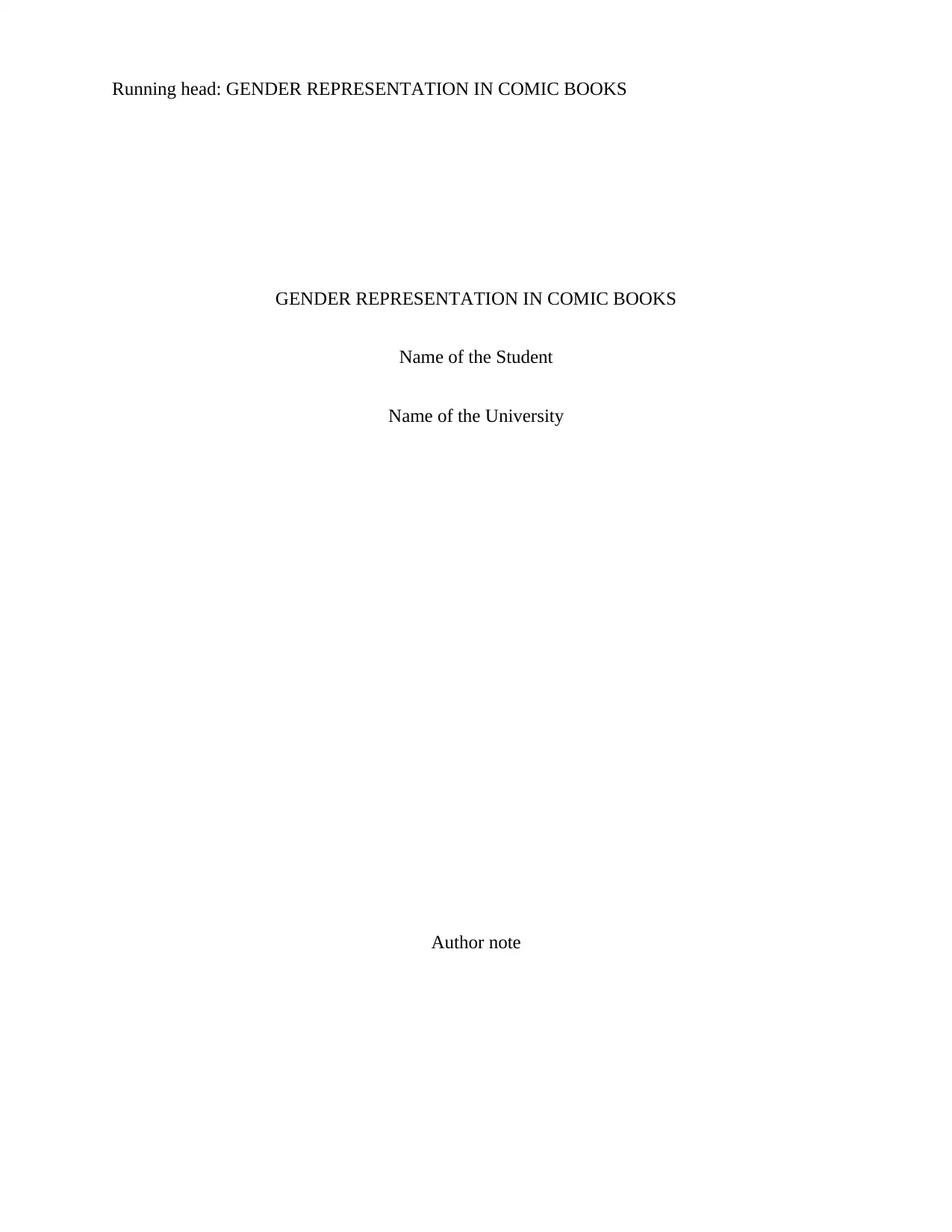
Running head: GENDER REPRESENTATION IN COMIC BOOKS
GENDER REPRESENTATION IN COMIC BOOKS
Name of the Student
Name of the University
Author note
GENDER REPRESENTATION IN COMIC BOOKS
Name of the Student
Name of the University
Author note
Secure Best Marks with AI Grader
Need help grading? Try our AI Grader for instant feedback on your assignments.
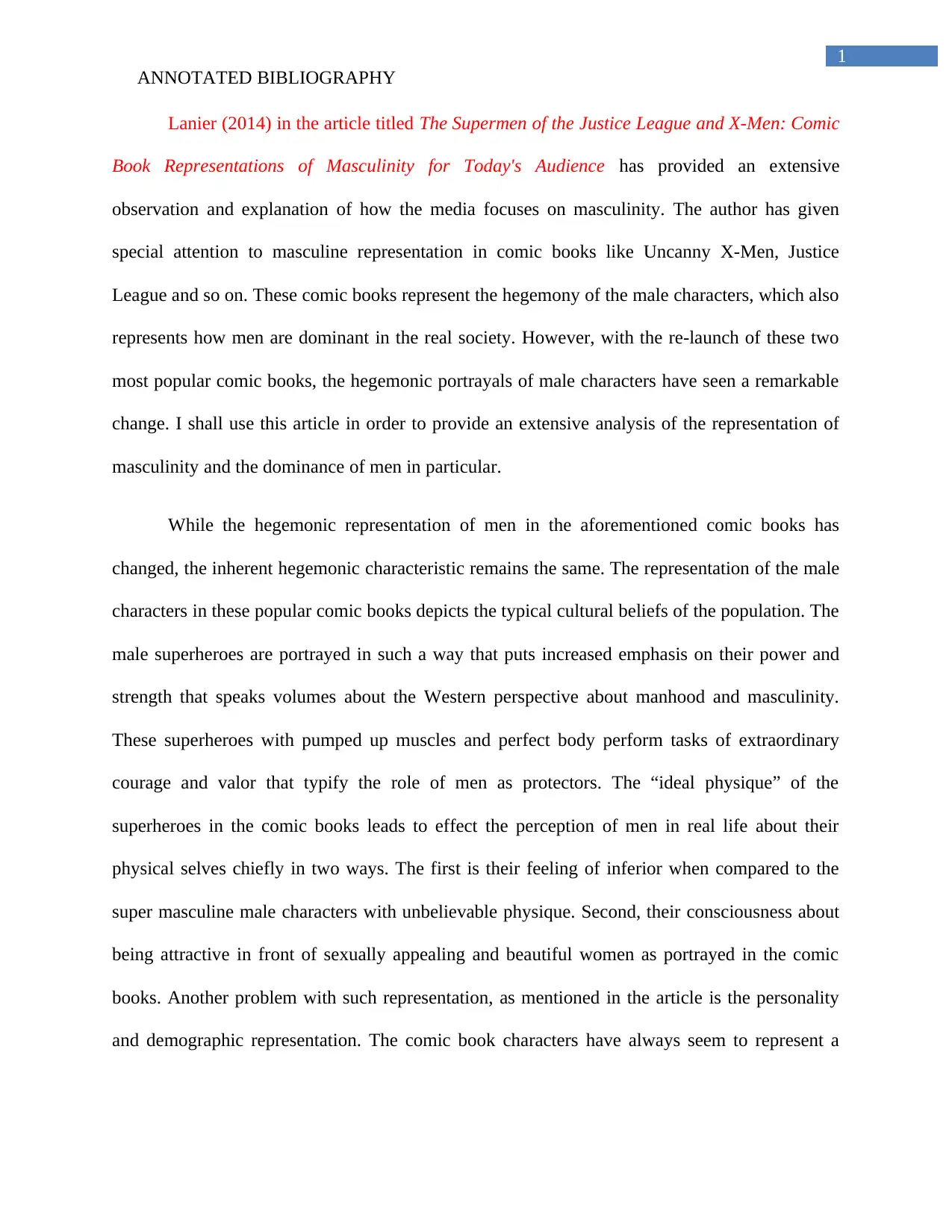
1
ANNOTATED BIBLIOGRAPHY
Lanier (2014) in the article titled The Supermen of the Justice League and X-Men: Comic
Book Representations of Masculinity for Today's Audience has provided an extensive
observation and explanation of how the media focuses on masculinity. The author has given
special attention to masculine representation in comic books like Uncanny X-Men, Justice
League and so on. These comic books represent the hegemony of the male characters, which also
represents how men are dominant in the real society. However, with the re-launch of these two
most popular comic books, the hegemonic portrayals of male characters have seen a remarkable
change. I shall use this article in order to provide an extensive analysis of the representation of
masculinity and the dominance of men in particular.
While the hegemonic representation of men in the aforementioned comic books has
changed, the inherent hegemonic characteristic remains the same. The representation of the male
characters in these popular comic books depicts the typical cultural beliefs of the population. The
male superheroes are portrayed in such a way that puts increased emphasis on their power and
strength that speaks volumes about the Western perspective about manhood and masculinity.
These superheroes with pumped up muscles and perfect body perform tasks of extraordinary
courage and valor that typify the role of men as protectors. The “ideal physique” of the
superheroes in the comic books leads to effect the perception of men in real life about their
physical selves chiefly in two ways. The first is their feeling of inferior when compared to the
super masculine male characters with unbelievable physique. Second, their consciousness about
being attractive in front of sexually appealing and beautiful women as portrayed in the comic
books. Another problem with such representation, as mentioned in the article is the personality
and demographic representation. The comic book characters have always seem to represent a
ANNOTATED BIBLIOGRAPHY
Lanier (2014) in the article titled The Supermen of the Justice League and X-Men: Comic
Book Representations of Masculinity for Today's Audience has provided an extensive
observation and explanation of how the media focuses on masculinity. The author has given
special attention to masculine representation in comic books like Uncanny X-Men, Justice
League and so on. These comic books represent the hegemony of the male characters, which also
represents how men are dominant in the real society. However, with the re-launch of these two
most popular comic books, the hegemonic portrayals of male characters have seen a remarkable
change. I shall use this article in order to provide an extensive analysis of the representation of
masculinity and the dominance of men in particular.
While the hegemonic representation of men in the aforementioned comic books has
changed, the inherent hegemonic characteristic remains the same. The representation of the male
characters in these popular comic books depicts the typical cultural beliefs of the population. The
male superheroes are portrayed in such a way that puts increased emphasis on their power and
strength that speaks volumes about the Western perspective about manhood and masculinity.
These superheroes with pumped up muscles and perfect body perform tasks of extraordinary
courage and valor that typify the role of men as protectors. The “ideal physique” of the
superheroes in the comic books leads to effect the perception of men in real life about their
physical selves chiefly in two ways. The first is their feeling of inferior when compared to the
super masculine male characters with unbelievable physique. Second, their consciousness about
being attractive in front of sexually appealing and beautiful women as portrayed in the comic
books. Another problem with such representation, as mentioned in the article is the personality
and demographic representation. The comic book characters have always seem to represent a
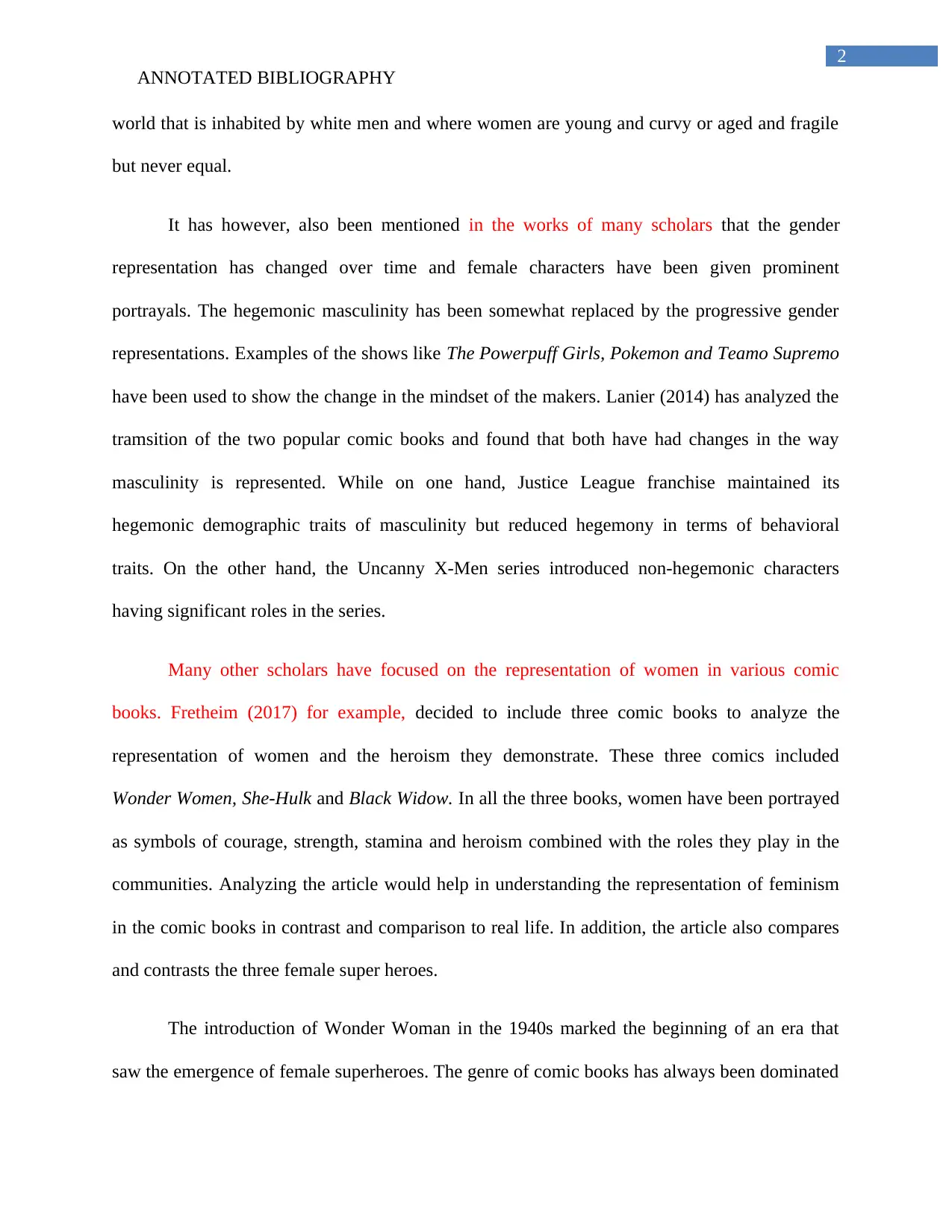
2
ANNOTATED BIBLIOGRAPHY
world that is inhabited by white men and where women are young and curvy or aged and fragile
but never equal.
It has however, also been mentioned in the works of many scholars that the gender
representation has changed over time and female characters have been given prominent
portrayals. The hegemonic masculinity has been somewhat replaced by the progressive gender
representations. Examples of the shows like The Powerpuff Girls, Pokemon and Teamo Supremo
have been used to show the change in the mindset of the makers. Lanier (2014) has analyzed the
tramsition of the two popular comic books and found that both have had changes in the way
masculinity is represented. While on one hand, Justice League franchise maintained its
hegemonic demographic traits of masculinity but reduced hegemony in terms of behavioral
traits. On the other hand, the Uncanny X-Men series introduced non-hegemonic characters
having significant roles in the series.
Many other scholars have focused on the representation of women in various comic
books. Fretheim (2017) for example, decided to include three comic books to analyze the
representation of women and the heroism they demonstrate. These three comics included
Wonder Women, She-Hulk and Black Widow. In all the three books, women have been portrayed
as symbols of courage, strength, stamina and heroism combined with the roles they play in the
communities. Analyzing the article would help in understanding the representation of feminism
in the comic books in contrast and comparison to real life. In addition, the article also compares
and contrasts the three female super heroes.
The introduction of Wonder Woman in the 1940s marked the beginning of an era that
saw the emergence of female superheroes. The genre of comic books has always been dominated
ANNOTATED BIBLIOGRAPHY
world that is inhabited by white men and where women are young and curvy or aged and fragile
but never equal.
It has however, also been mentioned in the works of many scholars that the gender
representation has changed over time and female characters have been given prominent
portrayals. The hegemonic masculinity has been somewhat replaced by the progressive gender
representations. Examples of the shows like The Powerpuff Girls, Pokemon and Teamo Supremo
have been used to show the change in the mindset of the makers. Lanier (2014) has analyzed the
tramsition of the two popular comic books and found that both have had changes in the way
masculinity is represented. While on one hand, Justice League franchise maintained its
hegemonic demographic traits of masculinity but reduced hegemony in terms of behavioral
traits. On the other hand, the Uncanny X-Men series introduced non-hegemonic characters
having significant roles in the series.
Many other scholars have focused on the representation of women in various comic
books. Fretheim (2017) for example, decided to include three comic books to analyze the
representation of women and the heroism they demonstrate. These three comics included
Wonder Women, She-Hulk and Black Widow. In all the three books, women have been portrayed
as symbols of courage, strength, stamina and heroism combined with the roles they play in the
communities. Analyzing the article would help in understanding the representation of feminism
in the comic books in contrast and comparison to real life. In addition, the article also compares
and contrasts the three female super heroes.
The introduction of Wonder Woman in the 1940s marked the beginning of an era that
saw the emergence of female superheroes. The genre of comic books has always been dominated
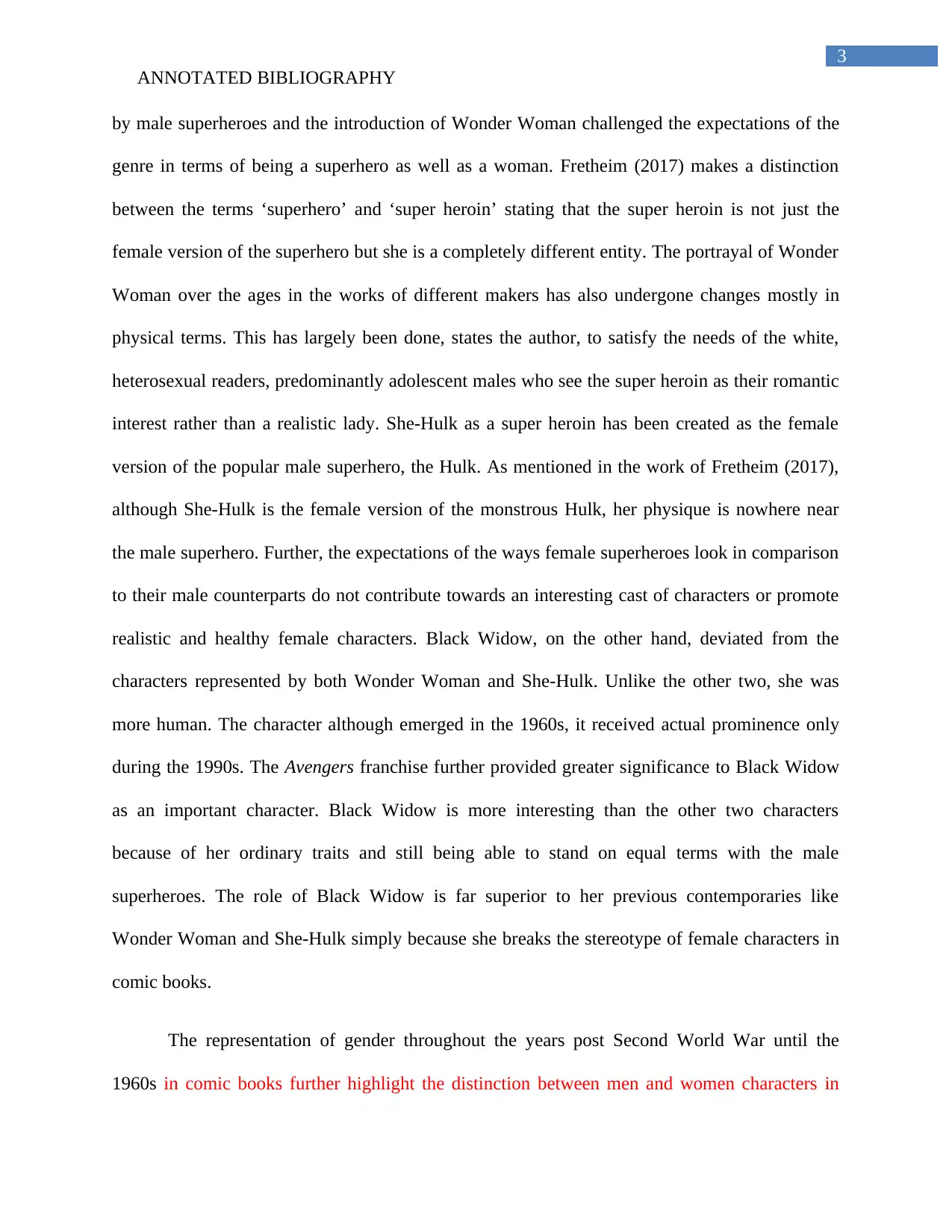
3
ANNOTATED BIBLIOGRAPHY
by male superheroes and the introduction of Wonder Woman challenged the expectations of the
genre in terms of being a superhero as well as a woman. Fretheim (2017) makes a distinction
between the terms ‘superhero’ and ‘super heroin’ stating that the super heroin is not just the
female version of the superhero but she is a completely different entity. The portrayal of Wonder
Woman over the ages in the works of different makers has also undergone changes mostly in
physical terms. This has largely been done, states the author, to satisfy the needs of the white,
heterosexual readers, predominantly adolescent males who see the super heroin as their romantic
interest rather than a realistic lady. She-Hulk as a super heroin has been created as the female
version of the popular male superhero, the Hulk. As mentioned in the work of Fretheim (2017),
although She-Hulk is the female version of the monstrous Hulk, her physique is nowhere near
the male superhero. Further, the expectations of the ways female superheroes look in comparison
to their male counterparts do not contribute towards an interesting cast of characters or promote
realistic and healthy female characters. Black Widow, on the other hand, deviated from the
characters represented by both Wonder Woman and She-Hulk. Unlike the other two, she was
more human. The character although emerged in the 1960s, it received actual prominence only
during the 1990s. The Avengers franchise further provided greater significance to Black Widow
as an important character. Black Widow is more interesting than the other two characters
because of her ordinary traits and still being able to stand on equal terms with the male
superheroes. The role of Black Widow is far superior to her previous contemporaries like
Wonder Woman and She-Hulk simply because she breaks the stereotype of female characters in
comic books.
The representation of gender throughout the years post Second World War until the
1960s in comic books further highlight the distinction between men and women characters in
ANNOTATED BIBLIOGRAPHY
by male superheroes and the introduction of Wonder Woman challenged the expectations of the
genre in terms of being a superhero as well as a woman. Fretheim (2017) makes a distinction
between the terms ‘superhero’ and ‘super heroin’ stating that the super heroin is not just the
female version of the superhero but she is a completely different entity. The portrayal of Wonder
Woman over the ages in the works of different makers has also undergone changes mostly in
physical terms. This has largely been done, states the author, to satisfy the needs of the white,
heterosexual readers, predominantly adolescent males who see the super heroin as their romantic
interest rather than a realistic lady. She-Hulk as a super heroin has been created as the female
version of the popular male superhero, the Hulk. As mentioned in the work of Fretheim (2017),
although She-Hulk is the female version of the monstrous Hulk, her physique is nowhere near
the male superhero. Further, the expectations of the ways female superheroes look in comparison
to their male counterparts do not contribute towards an interesting cast of characters or promote
realistic and healthy female characters. Black Widow, on the other hand, deviated from the
characters represented by both Wonder Woman and She-Hulk. Unlike the other two, she was
more human. The character although emerged in the 1960s, it received actual prominence only
during the 1990s. The Avengers franchise further provided greater significance to Black Widow
as an important character. Black Widow is more interesting than the other two characters
because of her ordinary traits and still being able to stand on equal terms with the male
superheroes. The role of Black Widow is far superior to her previous contemporaries like
Wonder Woman and She-Hulk simply because she breaks the stereotype of female characters in
comic books.
The representation of gender throughout the years post Second World War until the
1960s in comic books further highlight the distinction between men and women characters in
Secure Best Marks with AI Grader
Need help grading? Try our AI Grader for instant feedback on your assignments.
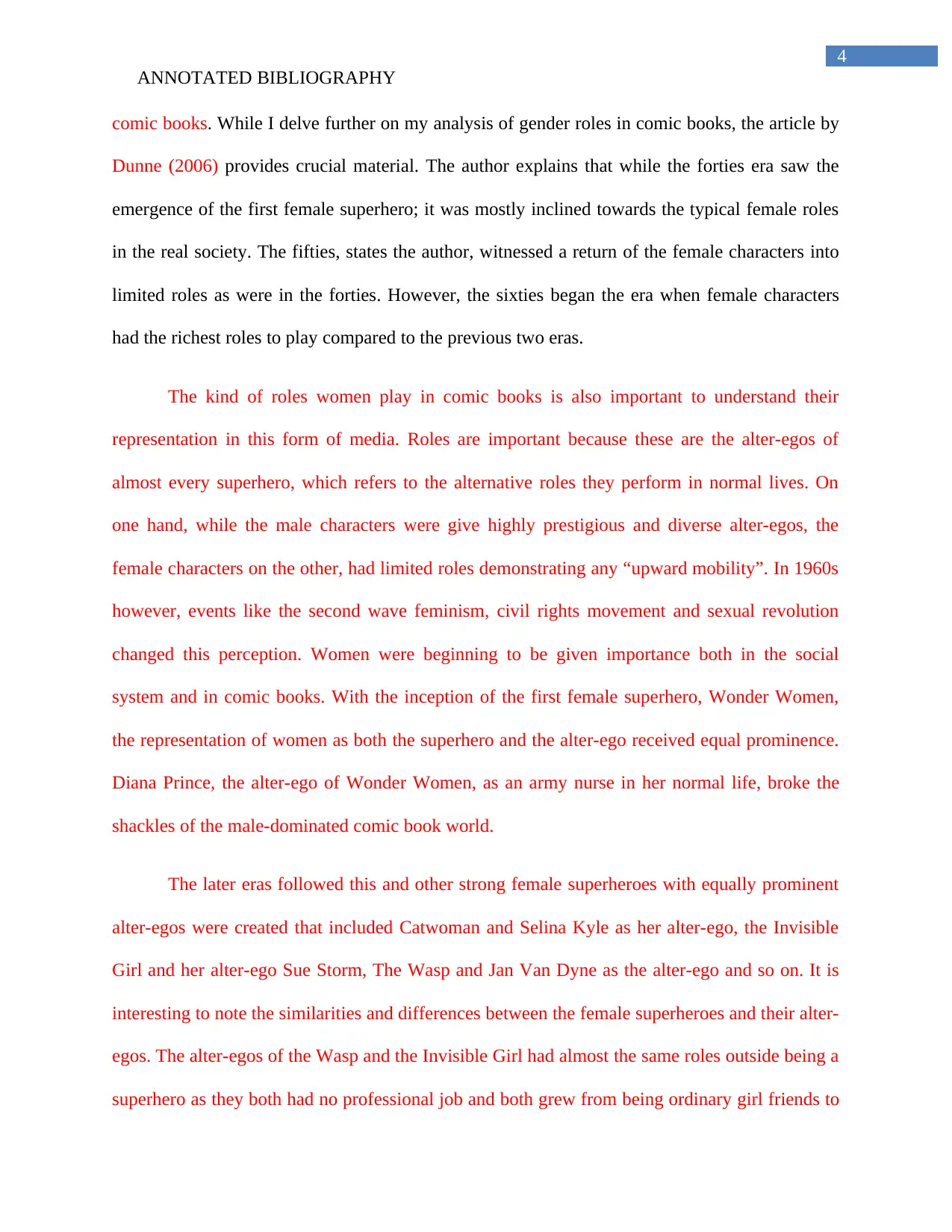
4
ANNOTATED BIBLIOGRAPHY
comic books. While I delve further on my analysis of gender roles in comic books, the article by
Dunne (2006) provides crucial material. The author explains that while the forties era saw the
emergence of the first female superhero; it was mostly inclined towards the typical female roles
in the real society. The fifties, states the author, witnessed a return of the female characters into
limited roles as were in the forties. However, the sixties began the era when female characters
had the richest roles to play compared to the previous two eras.
The kind of roles women play in comic books is also important to understand their
representation in this form of media. Roles are important because these are the alter-egos of
almost every superhero, which refers to the alternative roles they perform in normal lives. On
one hand, while the male characters were give highly prestigious and diverse alter-egos, the
female characters on the other, had limited roles demonstrating any “upward mobility”. In 1960s
however, events like the second wave feminism, civil rights movement and sexual revolution
changed this perception. Women were beginning to be given importance both in the social
system and in comic books. With the inception of the first female superhero, Wonder Women,
the representation of women as both the superhero and the alter-ego received equal prominence.
Diana Prince, the alter-ego of Wonder Women, as an army nurse in her normal life, broke the
shackles of the male-dominated comic book world.
The later eras followed this and other strong female superheroes with equally prominent
alter-egos were created that included Catwoman and Selina Kyle as her alter-ego, the Invisible
Girl and her alter-ego Sue Storm, The Wasp and Jan Van Dyne as the alter-ego and so on. It is
interesting to note the similarities and differences between the female superheroes and their alter-
egos. The alter-egos of the Wasp and the Invisible Girl had almost the same roles outside being a
superhero as they both had no professional job and both grew from being ordinary girl friends to
ANNOTATED BIBLIOGRAPHY
comic books. While I delve further on my analysis of gender roles in comic books, the article by
Dunne (2006) provides crucial material. The author explains that while the forties era saw the
emergence of the first female superhero; it was mostly inclined towards the typical female roles
in the real society. The fifties, states the author, witnessed a return of the female characters into
limited roles as were in the forties. However, the sixties began the era when female characters
had the richest roles to play compared to the previous two eras.
The kind of roles women play in comic books is also important to understand their
representation in this form of media. Roles are important because these are the alter-egos of
almost every superhero, which refers to the alternative roles they perform in normal lives. On
one hand, while the male characters were give highly prestigious and diverse alter-egos, the
female characters on the other, had limited roles demonstrating any “upward mobility”. In 1960s
however, events like the second wave feminism, civil rights movement and sexual revolution
changed this perception. Women were beginning to be given importance both in the social
system and in comic books. With the inception of the first female superhero, Wonder Women,
the representation of women as both the superhero and the alter-ego received equal prominence.
Diana Prince, the alter-ego of Wonder Women, as an army nurse in her normal life, broke the
shackles of the male-dominated comic book world.
The later eras followed this and other strong female superheroes with equally prominent
alter-egos were created that included Catwoman and Selina Kyle as her alter-ego, the Invisible
Girl and her alter-ego Sue Storm, The Wasp and Jan Van Dyne as the alter-ego and so on. It is
interesting to note the similarities and differences between the female superheroes and their alter-
egos. The alter-egos of the Wasp and the Invisible Girl had almost the same roles outside being a
superhero as they both had no professional job and both grew from being ordinary girl friends to
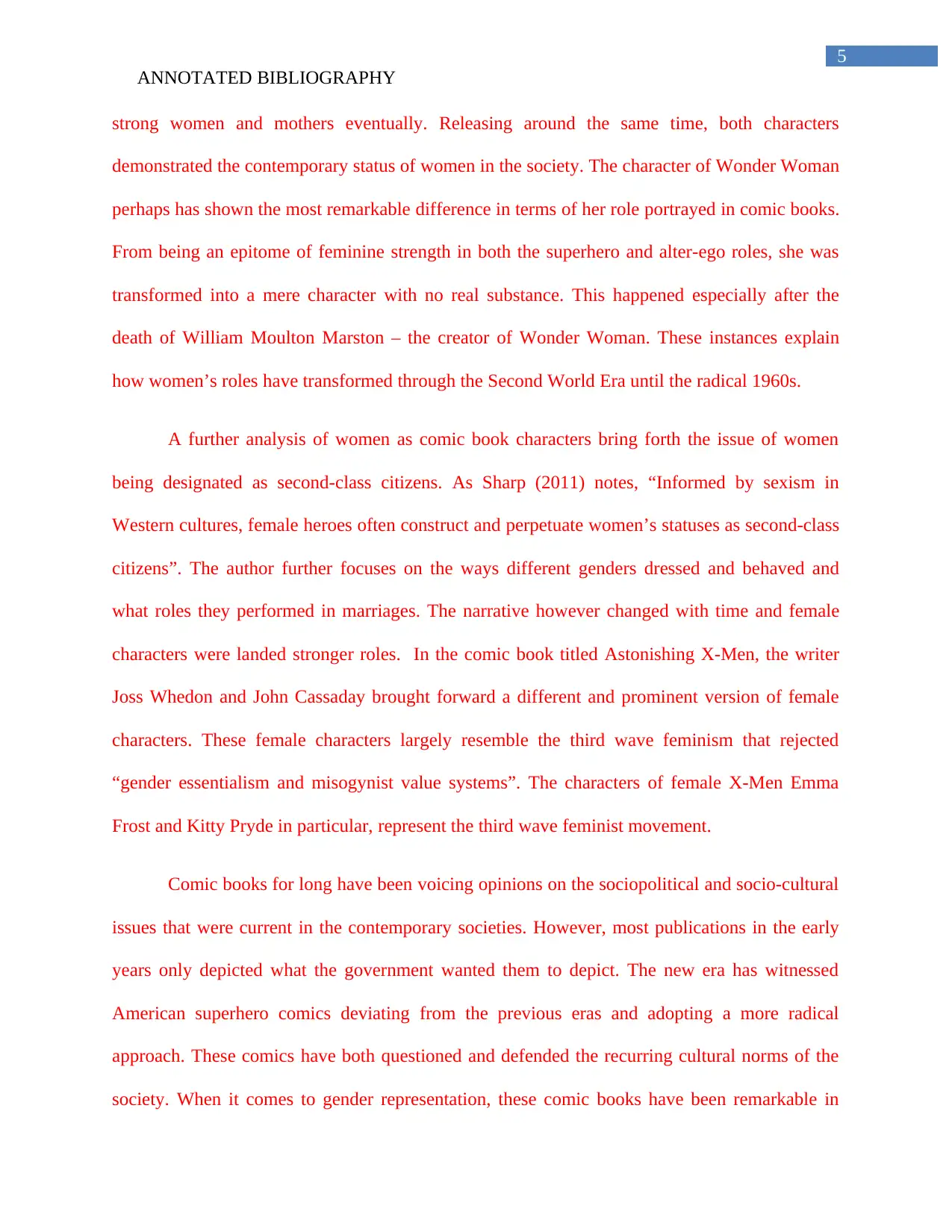
5
ANNOTATED BIBLIOGRAPHY
strong women and mothers eventually. Releasing around the same time, both characters
demonstrated the contemporary status of women in the society. The character of Wonder Woman
perhaps has shown the most remarkable difference in terms of her role portrayed in comic books.
From being an epitome of feminine strength in both the superhero and alter-ego roles, she was
transformed into a mere character with no real substance. This happened especially after the
death of William Moulton Marston – the creator of Wonder Woman. These instances explain
how women’s roles have transformed through the Second World Era until the radical 1960s.
A further analysis of women as comic book characters bring forth the issue of women
being designated as second-class citizens. As Sharp (2011) notes, “Informed by sexism in
Western cultures, female heroes often construct and perpetuate women’s statuses as second-class
citizens”. The author further focuses on the ways different genders dressed and behaved and
what roles they performed in marriages. The narrative however changed with time and female
characters were landed stronger roles. In the comic book titled Astonishing X-Men, the writer
Joss Whedon and John Cassaday brought forward a different and prominent version of female
characters. These female characters largely resemble the third wave feminism that rejected
“gender essentialism and misogynist value systems”. The characters of female X-Men Emma
Frost and Kitty Pryde in particular, represent the third wave feminist movement.
Comic books for long have been voicing opinions on the sociopolitical and socio-cultural
issues that were current in the contemporary societies. However, most publications in the early
years only depicted what the government wanted them to depict. The new era has witnessed
American superhero comics deviating from the previous eras and adopting a more radical
approach. These comics have both questioned and defended the recurring cultural norms of the
society. When it comes to gender representation, these comic books have been remarkable in
ANNOTATED BIBLIOGRAPHY
strong women and mothers eventually. Releasing around the same time, both characters
demonstrated the contemporary status of women in the society. The character of Wonder Woman
perhaps has shown the most remarkable difference in terms of her role portrayed in comic books.
From being an epitome of feminine strength in both the superhero and alter-ego roles, she was
transformed into a mere character with no real substance. This happened especially after the
death of William Moulton Marston – the creator of Wonder Woman. These instances explain
how women’s roles have transformed through the Second World Era until the radical 1960s.
A further analysis of women as comic book characters bring forth the issue of women
being designated as second-class citizens. As Sharp (2011) notes, “Informed by sexism in
Western cultures, female heroes often construct and perpetuate women’s statuses as second-class
citizens”. The author further focuses on the ways different genders dressed and behaved and
what roles they performed in marriages. The narrative however changed with time and female
characters were landed stronger roles. In the comic book titled Astonishing X-Men, the writer
Joss Whedon and John Cassaday brought forward a different and prominent version of female
characters. These female characters largely resemble the third wave feminism that rejected
“gender essentialism and misogynist value systems”. The characters of female X-Men Emma
Frost and Kitty Pryde in particular, represent the third wave feminist movement.
Comic books for long have been voicing opinions on the sociopolitical and socio-cultural
issues that were current in the contemporary societies. However, most publications in the early
years only depicted what the government wanted them to depict. The new era has witnessed
American superhero comics deviating from the previous eras and adopting a more radical
approach. These comics have both questioned and defended the recurring cultural norms of the
society. When it comes to gender representation, these comic books have been remarkable in
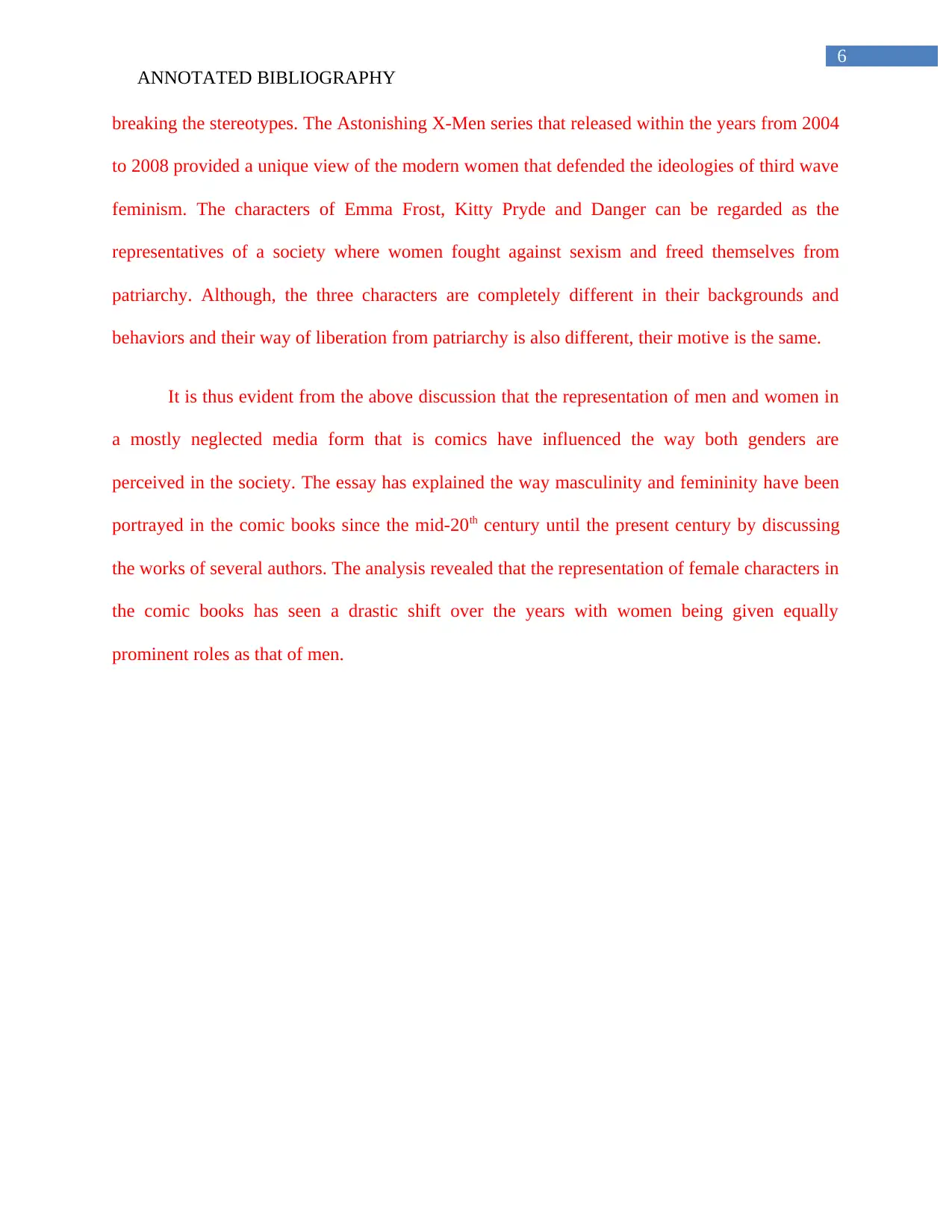
6
ANNOTATED BIBLIOGRAPHY
breaking the stereotypes. The Astonishing X-Men series that released within the years from 2004
to 2008 provided a unique view of the modern women that defended the ideologies of third wave
feminism. The characters of Emma Frost, Kitty Pryde and Danger can be regarded as the
representatives of a society where women fought against sexism and freed themselves from
patriarchy. Although, the three characters are completely different in their backgrounds and
behaviors and their way of liberation from patriarchy is also different, their motive is the same.
It is thus evident from the above discussion that the representation of men and women in
a mostly neglected media form that is comics have influenced the way both genders are
perceived in the society. The essay has explained the way masculinity and femininity have been
portrayed in the comic books since the mid-20th century until the present century by discussing
the works of several authors. The analysis revealed that the representation of female characters in
the comic books has seen a drastic shift over the years with women being given equally
prominent roles as that of men.
ANNOTATED BIBLIOGRAPHY
breaking the stereotypes. The Astonishing X-Men series that released within the years from 2004
to 2008 provided a unique view of the modern women that defended the ideologies of third wave
feminism. The characters of Emma Frost, Kitty Pryde and Danger can be regarded as the
representatives of a society where women fought against sexism and freed themselves from
patriarchy. Although, the three characters are completely different in their backgrounds and
behaviors and their way of liberation from patriarchy is also different, their motive is the same.
It is thus evident from the above discussion that the representation of men and women in
a mostly neglected media form that is comics have influenced the way both genders are
perceived in the society. The essay has explained the way masculinity and femininity have been
portrayed in the comic books since the mid-20th century until the present century by discussing
the works of several authors. The analysis revealed that the representation of female characters in
the comic books has seen a drastic shift over the years with women being given equally
prominent roles as that of men.
Paraphrase This Document
Need a fresh take? Get an instant paraphrase of this document with our AI Paraphraser

7
ANNOTATED BIBLIOGRAPHY
References:
Dunne, M. (2006). The representation of women in comic books, post WWII through the radical
60’s. PSU McNair Scholars Online Journal, 2(1), 13.
Fretheim, I. M. (2017). Fantastic Feminism: Female Characters in Superhero Comic Books.
Master's thesis.
Lanier, T. M. (2014). The Supermen of the Justice League and X-Men: Comic Book
Representations of Masculinity for Today's Audience. Doctoral dissertation, University
of Georgia.
Sharp, M. L. (2011). Gender, feminism, and heroism in Joss Whedon and John Cassaday's
Astonishing X-Men comics.
ANNOTATED BIBLIOGRAPHY
References:
Dunne, M. (2006). The representation of women in comic books, post WWII through the radical
60’s. PSU McNair Scholars Online Journal, 2(1), 13.
Fretheim, I. M. (2017). Fantastic Feminism: Female Characters in Superhero Comic Books.
Master's thesis.
Lanier, T. M. (2014). The Supermen of the Justice League and X-Men: Comic Book
Representations of Masculinity for Today's Audience. Doctoral dissertation, University
of Georgia.
Sharp, M. L. (2011). Gender, feminism, and heroism in Joss Whedon and John Cassaday's
Astonishing X-Men comics.
1 out of 8
Your All-in-One AI-Powered Toolkit for Academic Success.
+13062052269
info@desklib.com
Available 24*7 on WhatsApp / Email
![[object Object]](/_next/static/media/star-bottom.7253800d.svg)
Unlock your academic potential
© 2024 | Zucol Services PVT LTD | All rights reserved.
